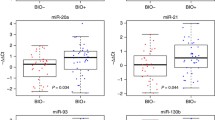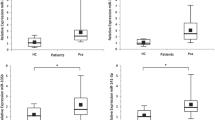Abstract
To compare the expression of two promising circulating micro-ribonucleic acids (miRNAs 21 and 221) in patients with prostate cancer to subjects without cancer and to evaluate their potential role as specific noninvasive molecular biomarkers for prostate cancer diagnosis, circulating miRNAs 21 and 221 expression profiles were analyzed in 20 men aged 50–75 years, presenting with lower urinary tract symptoms (LUTSs) and undergoing transrectal ultrasound (TRUS)-guided prostate biopsy based on either elevated serum prostate-specific antigen (PSA) (>4.0 ng/ml) or suspicious digital rectal examination (DRE). The performance of miRNAs 21 and 221 in differentiating prostate cancer from nonmalignant cases was evaluated and compared to DRE and elevated PSA. miRNA 21 was overexpressed in 90 % of group A vs. 10 % of group B, while miRNA 221 was overexpressed in 80 % of group A vs. 20 % of group B (p = 0.001). MiRNA 21 overexpression had the highest performance as a diagnostic test with a sensitivity of 90 % and a specificity 90 % (p = 0.02). No correlations were noted between Gleason score of prostate cancer cases and relative quantity (RQ) 21 (r = −0.355, p = 0.292) or RQ 221 (r = −0.044, p = 0.892). Our study showed that serum miRNAs 21 and 221 expression profiling tests may be used as specific noninvasive molecular biomarkers for prostate cancer diagnosis due to their higher sensitivity and specificity with a high negative predictive value leading to a decrease in the biopsies taken for patients with elevated serum PSA values.
Similar content being viewed by others
References
Porkka KP, Pfeiffer MJ, Waltering KK, et al. MicroRNA expression profiling in prostate cancer. Cancer Res. 2007;67:6130–5.
Huang X, Liang M, Dittmar R, Wang L. Extracellular microRNAs in urologic malignancies: chances and challenges. Int J Mol Sci. 2013;14:14785–99.
Ribas J, Ni X, Haffner M, et al. miR-21: an androgen receptor-regulated microRNA that promotes hormone-dependent and hormone-independent prostate cancer growth. Cancer Res. 2009;69:7165–9.
Waltering K, Porkka K, Jalava S, Urbanucci A, Kohonen P, Latonen L, et al. Androgen regulation of micro-RNAs in prostate cancer. Prostate. 2011;71:604–14.
Calin GA, Liu CG, Sevignani C, et al. MicroRNA profiling reveals distinct signatures in B cell chronic lymphocytic leukemias. Proc Natl Acad Sci U S A. 2004;101:11755–60.
Ma R, Jiang T, Kang X. Circulating microRNAs in cancer: origin, function and application. J Exp Clin Cancer Res. 2012;31:38.
Papagiannakopoulos T, Shapiro A, Kosik KS. MicroRNA-21 targets a network of key tumor-suppressive pathways in glioblastoma cells. Cancer Res. 2008;68:8164–72.
Lu Z, Liu M, Stribinskis V, et al. MicroRNA-21 promotes cell transformation by targeting the programmed cell death 4 gene. Oncogene. 2008;27:4373–9.
Liu LZ, Li C, Chen Q, Jing Y, Carpenter R, Jiang Y, et al. MiR-21 induced angiogenesis through AKT and ERK activation and HIF-1α expression. PLoS ONE. 2011;6(4):e19139. doi:10.1371/journal.pone.0019139.
Galardi S, Mercatelli N, Giorda E, Massalini S, Frajese GV, Ciafrè SA, et al. miR-221 and miR-222 expression affects the proliferation potential of human prostate carcinoma cell lines by targeting p27Kip1. J Biol Chem. 2007;282(32):23716–24.
Sun T, Wang Q, Balk S, Brown M, Lee GS, Kantoff P. The role of microRNA-221 and microRNA-222 in androgen-independent prostate cancer cell lines. Cancer Res. 2009;69:3356–63.
Reid G, Kirschner MB, van Zandwijk N. Circulating microRNAs: association with disease and potential use as biomarkers. Crit Rev Oncol Hematol. 2011;80:193–208.
Brase JC, Johannes M, Schlomm T, et al. Circulating miRNAs are correlated with tumor progression in prostate cancer. lnt J Cancer. 2011;128:608–16.
Mitchell PS, Parkin RK, Kroh EM, et al. Circulating microRNAs as stable blood-based markers for cancer detection. Proc Natl Acad Sci U S A. 2008;105:10513–8.
Moltzahn F, Olshen AB, Baehner L, et al. Microfluidic based multiplex qRT-PCR identifies diagnostic and prognostic microRNA signatures in sera of prostate cancer patients. Cancer Res. 2011;71:550.
Lodes MJ, Caraballo M, Suciu D, Munro S, Kumar A, Anderson B. Detection of cancer with serum miRNAs on an oligonucleotide microarray. PLoS ONE. 2009;4:e6229.
Chen ZH, Zhang GL, Li HR, Luo JD, Li ZX, Chen GM, et al. A panel of five circulating microRNAs as potential biomarkers for prostate cancer. Prostate. 2012;72:1443–52.
Mahn R, Heukamp LC, Rogenhofer S, von Ruecker A, Muller SC, Ellinger J. Circulating microRNAs (miRNA) in serum of patients with prostate cancer. Urology. 2011;77:1265.e9–16.
Zhang HL, Yang LF, Zhu Y, et al. Serum miRNA-21: elevated levels in patients with metastatic hormone-refractory prostate cancer and potential predictive factor for the efficacy of docetaxel-based chemotherapy. Prostate. 2011;71:326–31.
Agaoglu FY, Kovancilar M, Dizdar Y, Darendeliler E, Holdenrieder S, Dalay N, et al. Investigation of miR-21, miR-141, and miR-221 in blood circulation of patients with prostate cancer. Tumor Biol. 2011;32:583–8.
Shen J, Hruby GW, McKiernan JM, Gurvich I, Lipsky MJ, Benson MC, et al. Dysregulation of circulating microRNAs and prediction of aggressive prostate cancer. Prostate. 2012;72:1469–77.
Spahn M, Kneitz S, Scholz CJ, Stenger N, Rudiger T, Strobel P, et al. Expression of microRNA-221 is progressively reduced in aggressive prostate cancer and metastasis and predicts clinical recurrence. Int J Cancer. 2010;127(2):394–403.
Schaefer A, Jung M, Mollenkopf HJ, Wagner I, Stephan C, Jentzmik F, et al. Diagnostic and prognostic implications of microRNA profiling in prostate carcinoma. Int J Cancer. 2010;126(5):1166–76.
Kang SG, Ha YR, Kim SJ, et al. Do microRNA 96, 145 and 221 expressions really aid in the prognosis of prostate carcinoma. Asian J Androl. 2012;14:752–7.
Author information
Authors and Affiliations
Corresponding author
Rights and permissions
About this article
Cite this article
Kotb, S., Mosharafa, A., Essawi, M. et al. Circulating miRNAs 21 and 221 as biomarkers for early diagnosis of prostate cancer. Tumor Biol. 35, 12613–12617 (2014). https://doi.org/10.1007/s13277-014-2584-7
Received:
Accepted:
Published:
Issue Date:
DOI: https://doi.org/10.1007/s13277-014-2584-7




